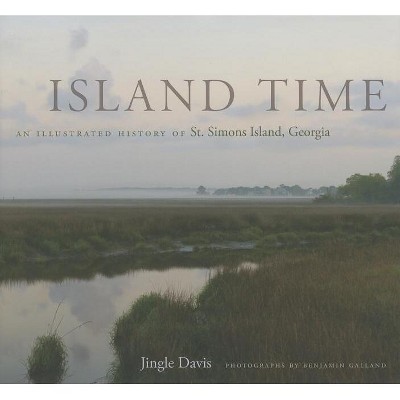Sponsored

Following the Tabby Trail - (Wormsloe Foundation Publications) by Jingle Davis (Hardcover)
$25.48 was $28.27
New lower price
save $2.79 (10% reduction)In Stock
Eligible for registries and wish lists
Sponsored
About this item
Highlights
- Following the Tabby Trail provides a guided tour of some of the most significant tabby structures found along the southeastern coast and includes more than two hundred illustrations that highlight the human and architectural histories of forty-eight specific sites.
- About the Author: Jingle Davis (Author) JINGLE DAVIS was a retired journalist who worked for the Atlanta Journal-Constitution for over twenty years, often covering South Georgia and the coast.
- 352 Pages
- Travel, United States
- Series Name: Wormsloe Foundation Publications
Description
About the Book
"Following the Tabby Trail provides a guided tour of some of the most significant tabby structures found along the southeastern coast and includes more than two hundred illustrations that highlight the human and architectural histories of forty-eight specific sites. Jingle Davis explains how tabby - a unique oyster-shell concrete - helps us to understand the complex past of the coast. A tabby structure is, as the author puts it, "a storehouse of history." Each of the site descriptions includes the intriguing profile of a historic figure associated in some way with the tabby. Though the first documented use of tabby in North America was in 1672 in what is now St. Augustine, Florida, Spanish colonists had used many of its constituent parts a century earlier. In addition to their Spanish-speaking competitors, colonizers from France and the British Isles also enthusiastically adopted the building material for their colonial missions. This meant, of course, that enslaved Africans and Indigenous peoples built with the material. Tabby remained a fashionable, effective, and enduring building material until shortly after the Civil War. This richly photographed work provides readers with a guide to the underexplored string of tabby structures still standing along the stretch of coast between Florida and South Carolina, an approximately 275-mile trail traced by the book from just south of St. Augustine north to the dead town of Dorchester near Summerville. Sites include such varied structures as ancient Late Archaic shell mounds called middens and rings of shells thousands of years old. Fort Matanzas, built in 1742 but named for a sixteenth-century massacre of French colonists by St. Augustine's Spanish founder Pedro Menâendez de Avilâes. Fort Mose, a significant feature of Florida's Black Heritage Trail, and homes of the enslaved, warehouses, Charleston's seawall, churches, and cemeteries"--Book Synopsis
Following the Tabby Trail provides a guided tour of some of the most significant tabby structures found along the southeastern coast and includes more than two hundred illustrations that highlight the human and architectural histories of forty-eight specific sites. Jingle Davis explains how tabby--a unique oyster-shell concrete--helps us to understand the complex past of the coast. A tabby structure is, as the author puts it, "a storehouse of history." Each of the site descriptions includes the intriguing profile of a historic figure associated in some way with the tabby.
Though the first documented use of tabby in North America was in 1672 in what is now St. Augustine, Florida, Spanish colonists had used many of its constituent parts a century earlier. In addition to their Spanish-speaking competitors, colonizers from France and the British Isles also enthusiastically adopted the building material for their colonial missions. This meant, of course, that enslaved Africans and Indigenous peoples built with the material. Tabby remained a fashionable, effective, and enduring building material until shortly after the Civil War. This richly photographed work provides readers with a guide to the underexplored string of tabby structures still standing along the stretch of coast between Florida and South Carolina, an approximately 275-mile trail traced by the book from just south of St. Augustine north to the dead town of Dorchester near Summerville. Sites include such varied structures as ancient Late Archaic shell mounds called middens and rings of shells thousands of years old; Fort Matanzas, built in 1742 but named for a sixteenth-century massacre of French colonists by St. Augustine's Spanish founder Pedro Menéndez de Avilés; Fort Mose, a significant feature of Florida's Black Heritage Trail; and homes of the enslaved, warehouses, Charleston's seawall, churches, and cemeteries.Review Quotes
From my perspective, the single most valuable contribution of Following the Tabby Trail is that it brings the history of Spanish Florida into the realm of Georgia and Carolina history. By shining a different light on well-established stories, Davis is tying together a diverse region with all that this implies in terms of understanding people and their cultures.--Paul M. Pressly "coeditor of Coastal Nature, Coastal Culture: Environmental Histories of the Georgia Coast"
Like dinosaur bones, tabby ruins litter the coastal plain from St. Augustine to Charleston, silent sentinels of a distant time when Europeans and enslaved Natives and Africans left permanent marks on the Atlantic coast. In this monumental undertaking, Following the Tabby Trail, Jingle Davis brings to light stories from our past that have been locked in stone for centuries. Enhanced by Ben Galland's striking photography, this book represents a significant addition to the collective history of the Southeast coast.--Stephen Doster "author Cumberland Island: Footsteps in Time (Georgia)"
About the Author
Jingle Davis (Author)JINGLE DAVIS was a retired journalist who worked for the Atlanta Journal-Constitution for over twenty years, often covering South Georgia and the coast. She is the author of Island Time: An Illustrated History of St. Simons Island, Georgia and Island Passages: An Illustrated History of Jekyll Island, Georgia (both Georgia). Benjamin Galland (Photographer)
BENJAMIN GALLAND, born and raised on St. Simons Island, grew up exploring and photographing the pristine and unparalleled beauty of the southeastern coast. Aside from his artistic photography, he owns Volo Project and offers commercial marketing photography specializing in lifestyle, tourism, hospitality, food, and conservation. With a passion for storytelling, the outdoors, and conservation, Galland uses his camera to portray the things that matter most to him. He has five books published with the University of Georgia Press: Island Time: An Illustrated History of St. Simons Island, Georgia; Island Passages: An Illustrated History of Jekyll Island, Georgia; Sapelo: People and Place on a Georgia Sea Island; Cumberland Island: Footsteps in Time; and Following the Tabby Trail: Where Coastal History Is Captured in Unique Oyster-Shell Structures. Galland is an avid outdoorsman and enjoys kayaking, fly-fishing, camping, and exploring.
Dimensions (Overall): 8.3 Inches (H) x 8.2 Inches (W) x .79 Inches (D)
Weight: 2.3 Pounds
Suggested Age: 22 Years and Up
Number of Pages: 352
Genre: Travel
Sub-Genre: United States
Series Title: Wormsloe Foundation Publications
Publisher: University of Georgia Press
Theme: South Atlantic (DC, DE, FL, GA, MD, NC, SC, VA, WV), South
Format: Hardcover
Author: Jingle Davis
Language: English
Street Date: June 1, 2022
TCIN: 88966954
UPC: 9780820357492
Item Number (DPCI): 247-15-6600
Origin: Made in the USA or Imported
If the item details aren’t accurate or complete, we want to know about it.
Shipping details
Estimated ship dimensions: 0.79 inches length x 8.2 inches width x 8.3 inches height
Estimated ship weight: 2.3 pounds
We regret that this item cannot be shipped to PO Boxes.
This item cannot be shipped to the following locations: American Samoa (see also separate entry under AS), Guam (see also separate entry under GU), Northern Mariana Islands, Puerto Rico (see also separate entry under PR), United States Minor Outlying Islands, Virgin Islands, U.S., APO/FPO
Return details
This item can be returned to any Target store or Target.com.
This item must be returned within 90 days of the date it was purchased in store, shipped, delivered by a Shipt shopper, or made ready for pickup.
See the return policy for complete information.






